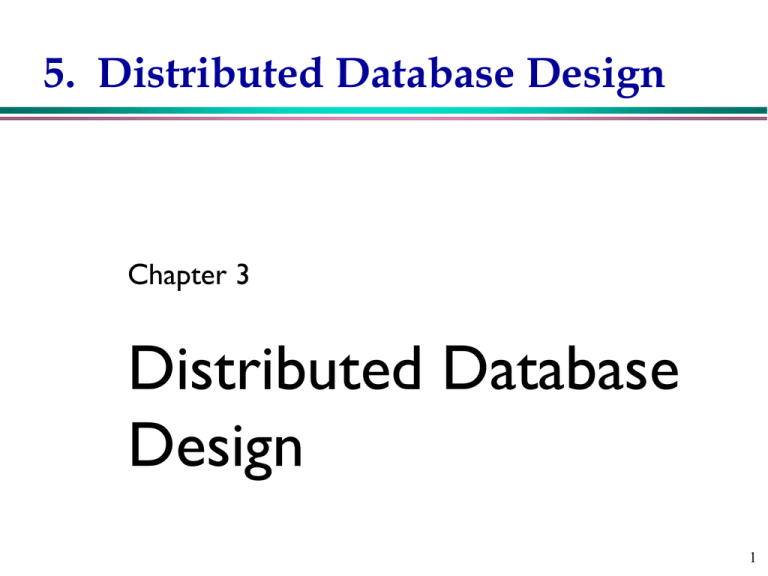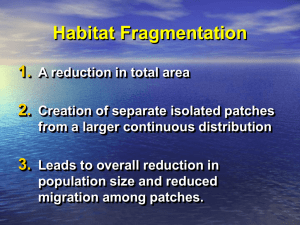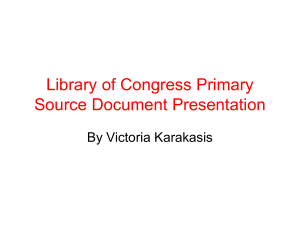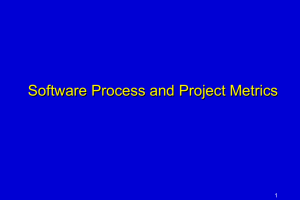
5. Distributed Database Design
Chapter 3
Distributed Database
Design
1
Outline
Introduction
Fragmentation (片段划分)
Horizontal fragmentation (水平划分)
Derived horizontal fragmentation (导出式水平划分)
Vertical fragmentation (垂直划分)
Allocation (片段分配)
2
Outline
Introduction
Fragmentation (片段划分)
Horizontal fragmentation (水平划分)
Derived horizontal fragmentation (导出式水平划分)
Vertical fragmentation (垂直划分)
Allocation (片段分配)
3
Distributed Database Design
The design of a distributed computer system
involves making decisions on the placement of data
and programs across the sites of a computer
network.
In distributed DBMSs, such placement involves two
things:
Placement of the DDBMS software
Placement of the applications that run on the database
The course concentrates on distribution of data.
The distribution of DDBMS and applications are given a
priori.
4
Framework of Distribution
Behavior of access pattern
Dynamic
Static
Complete
Information
No sharing
Data sharing
Data + program
sharing
Level of sharing
Level of knowledge
on access pattern
behavior
Partial
Information
5
Design Strategies
Top-Down
Mostly in designing systems from scratch
Mostly in designing homogeneous systems
Bottom-up
When the databases already exist at a number of sites
Combining both
6
Top-Down Design Process
User Input
Requirement Analysis
User Input
Objectives
Conceptual Design
GCS
View Integration
View Design
Access Information
Distribution Design
ES’s
User Input
LCS’s
Physical Design
LIS’s
7
Distribution Design Issues
Fragmentation
Why fragmentation at all?
How should we fragment?
How much should we fragment?
How to test correctness of decomposition?
Allocation
Necessary information required for fragmentation
and allocation
8
Why Fragment?
Can’t we just distribute relations?
What is a reasonable unit of distribution?
Relation
– Views are subsets of relations locality
– Extra communication cost
Fragments of relations (sub-relations)
9
Fragmentation
Unit of distribution
= unit of data application accesses
Reduce irrelevant data access
Facilitate intra-query concurrency over different fragments
Can be used with other performance enhancing methods
(e.g., indexing and clustering)
Applications have conflicting requirements, making disjoint
fragmentation a very hard problem
Multiple fragment access requires join or union
Semantic data control (integrity enforcement) could be very
costly
10
About fragmentation
How should we fragment?
Vertical Fragments sub grouping of attributes
Horizontal Fragments sub grouping of tuples
Mixed/Hybrid Fragments combination of above two
How much to fragment?
Too little too much of irrelevant data access
Too much too much processing cost
Need to find suitable level of fragmentation
11
Correctness Criteria
Completeness no loss of data
Decomposition of relation R into fragments R1, R2, …, Rn is
complete if and only if each data item in R can also be
found in some Ri .
Reconstruction
If relation R is decomposed into fragments R1, R2, …, Rn
then there should exist some relational operator such
that R = 1 i n Ri
Disjointness
If relation R is decomposed into fragments R1, R2, …, Rn
and data item di is in Rj, then di should not be in any other
fragment Rk (k!=j).
12
Allocation Alternatives
Full Replication
Each fragment resides at each site
Partial Replication
Each fragment resides at some of the sites
Not-replicated (Partitioned)
Each fragment resides at only one site
Q & A:
What are the advantages and disadvantages?
13
Allocation Alternatives
Full-Replication Partial -replication Partitioning
Query
Processing
Directory
Management
Concurrency
Control
Reliability
Reality
Easy
Same Difficulty
Easy or
non-existent
Same Difficulty
Moderate
Difficult
Easy
High
Possible
application
High
Low
Possible
application
Realistic
14
Rule of Thumb for Allocation
If number-of-read-only-queries is more than
number-of-update-queries,
then replication is advantageous, otherwise
replication may cause problems.
15
Information Requirements
Four categories
Database information
Application information
Communication network information
Computer system information
16
Outline
Introduction
Fragmentation (片段划分)
Horizontal fragmentation (水平划分)
Derived horizontal fragmentation (导出式水平划分)
Vertical fragmentation (垂直划分)
Allocation (片段分配)
17
Fragmentation
Horizontal fragmentation (HF)
Primary horizontal fragmentation (PHF)
– based on predicates accessing the relation
Derived horizontal fragmentation (DHF)
– based on predicates being defined on another logically related
relation
We shall first study algorithm for horizontal
fragmentation, and then study issues related to
derived horizontal fragmentation.
Vertical fragmentation (VF)
Hybrid fragmentation (HVF)
18
PHF Information Requirements
Database Information
> links
PAY
Title, Sal
EMP
L1
PROJ
Eno,Ename, Title
L2
Jno, Jname, Budget. Loc
L3
ASG
Eno, Jno, Resp, Dur
> Cardinality of each relation: card (R)
19
PHF Information Requirements (cont.)
Application
Information 1
Simple predicate: Given R(A1 , A2 , ..., An ), with each Ai
having domain of values dom(Ai), a simple predicate pj is
pj :
Ai Value
where {<, >, , , } and Value dom(Ai).
Example
Jname=“maintenance”
Budget 200000
Follow ``80/20'' rule
20
PHF Information Requirements (cont.)
Application
Information 2
minterm predicate: Given R and a set of simple
predicates Pr = {p1, p2, ..., pm} on R, the set of minterm
predicates M = {m 1, m 2 , ..., m z } is defined as
M = {mi | mi = Pj Pr p*j }, 1 i z, 1 j z
where p*j = pj or ¬pj
Example
m1:
m2:
m3:
m4:
(Jname=“maintenance”) (Budget 200000)
¬ (Jname=“maintenance”) (Budget 200000)
(Jname=“maintenance”) ¬ (Budget 200000)
¬ (Jname=“maintenance”) ¬ (Budget 200000)
21
PHF Information Requirements (cont.)
Application
Information 3
Minterm selectivity: sel (mi)
– number of tuples of the relation that would be accessed by a
user query specified according to a given minterm predicate.
Access frequency: acc (qi)
– frequency with which user applications access data. If Q = {q1 ,
q2 , ..., qn } is the set of queries, acc (qi ) indicates access
frequency of query qi in a given period.
22
Primary Horizontal Fragmentation
Each horizontal fragment Ri of relation R is defined
by Ri = Fi (R), 1 i w, where Fi is a selection
formula, which is (preferably) a minterm predicate.
A horizontal fragment Ri of relation R consists of all the
tuples of R which satisfy a minterm predicate mi.
Given a set of minterm predicates M, there are as
many as horizontal fragments of relation R as there
are minterm predicates.
Set of horizontal fragments also referred to as
minterm fragments
23
PHF - Algorithm
Input:
A relation R, a set of simple predicates Pr
Output: The set of fragments of R = {R1 , R2 , ..., Rw },
which obey the fragmentation rules.
Preliminaries:
Pr should be complete
Pr should be minimal
24
Completeness of Simple Predicates
A set of simple predicates Pr is said to be
complete if and only if the accesses to the tuples
of the minterm fragments defined on Pr requires
that two tuples of the same minterm fragment
have the same probability of being accessed by
any application.
25
Completeness of Simple Predicates
Example:
PNO
PNAME
BUDGET
LOC
P1 Instrumentation 150000 Mntreal
P2
Database
135000 New York
P3
CAD/CAM
250000 New York
P4
Maintenance
310000
Paris
Applications:
Q1: Find the projects at each location
Q2: Find projects with budget less than $200,000
incomplete
Predicates:
Pr={ LOC=“Montreal”, LOC=“New York”, LOC=“Paris”}
Pr={ LOC=“Montreal”, LOC=“New York”, LOC=“Paris”,
BUDGET 2000000, BUDGET >200000}
26
Minimality of Simple Predicates
If a predicate influences how fragmentation is
performed, (i.e., causes a fragment f to be further
fragmented into, say, fi and fj), then there should be
at least one application that accesses fi and fj
differently.
In other words, the simple predicate should be
relevant in determining a fragmentation.
If all the predicates of a set Pr are relevant, then Pr is
minimal.
27
Minimality of Simple Predicates
Example
Applications:
Q1: Find the projects at each location
Q2: Find projects with budget less than $200,000
Pr={ LOC=“Montreal”, LOC=“New York”, LOC=“Paris”,
BUDGET 2000000, BUDGET >200000}
minimal
Pr={ LOC=“Montreal”, LOC=“New York”, LOC=“Paris”,
BUDGET 2000000, BUDGET >200000,
Minimal??
PNAME=“Instrumentation”}
28
COM_MIN Algorithm
Input:
A relation R and a set of simple predicates Pr
Output: A complete and minimal set of simple
predicates Pr ’ for Pr
Rule 1: A relation or fragment is partitioned into at
least two parts which are accessed
differently by at least one application.
29
COM_MIN Algorithm (cont.)
1. Initialization
• Find a pi Pr such that pi partitions R according to Rule 1
• Set Pr’ = pi ; Pr Pr - pi ; F fi
2. Iteratively add predicates to Pr ’ until it is complete
• Find a pj Pr such that pj partitions some fk defined
according to minterm predicate over Pr’ according to Rule 1
• Pr’ pj ; Pr = Pr - pj ; F fj
• If pk Pr ’ which is nonrelevant, then
Pr ’ = Pr ’ - pk ; F F - fk
30
PHORIZONTAL Algorithm
Make use of COM_MIN to perform fragmentation
Input:
A relation R and a set of simple predicates Pr
Output: A set of minterm predicates M according to
which relation R is to be fragmented
Steps:
Pr ’ COM_MIN(R, Pr)
Determine the set M of minterm predicates
Determine the set I of implications among pi Pr ’
Eliminate the contradictory minterms from M
31
Contradictory Minterms
Given a minimal and complete set of simple
predicates, containing n simple predicates
Not all the minterm fragments derived are valid
A fragment can be self contradictory because of
implications among simple predicates.
Example:
Dom(Sal): [10000, 200000]; Dom(Loc) = {HK,SF}
p1 : sal < 50000;
p2 : Loc = HK;
p3 : Loc = SF
Note: p2 (¬ p3 ); p3 (¬ p2 )
the minterm p1 p2 p3 is self contradictory.
32
PHORIZONTAL Algorithm (cont.)
Input:
relation R and a set of simple predicates Pr
Output: a set of minterm fragments M
begin
Pr’ = COM-MIN(R, Pr );
M = set of minterm predicates from Pr’
I = set of implications among pi Pr’
for each mi M
if mi is contradictory according to I then
M = M mi
end
33
PHF Example: PAY
PAY
Application:
Check the salary info and determine raise
Employee records kept at two sites ==>
application runs at two sites
TITLE
Mech. Eng.
Programmer
Elec. Eng.
Syst. Anal.
SAL
27000
24000
40000
34000
Simple predicates: P1: SAL 30000, P2: SAL > 30000
Pr = {P1, P2}, which is complete and minimal
Pr’ = Pr
Minterm predicates: m1: (SAL 30000);
m2: (SAL > 30000)
PAY1
PAY2
TITLE
Mech. Eng.
Programmer
SAL
27000
24000
TITLE
Elec. Eng.
Syst. Anal.
SAL
40000
34000
34
PHF Example: PROJ
PROJ
Applications
Find the name and budget of
projects given their locations
– Issued at three sites
PNO
PNAME
BUDGET LOC
P1 Instrumentation 150000 Mntreal
P2
Database
135000 New York
P3
CAD/CAM 250000 New York
P4 Maintenance 310000
Paris
Access project information according
to budget
– One site access 200000; other
accesses >200000
m1: LOC = “Montreal” BUDGET 200000
m2 : LOC = “Montreal” BUDGET > 200000
m3 : LOC = “New York” BUDGET 200000
m4 : LOC = “New York” BUDGET > 200000
m5 : LOC = “Paris” BUDGET 200000
M6 : LOC = “Paris” BUDGET > 200000
p1: LOC = “Montreal”
p2 : LOC = “New York”
p3 : LOC = “Paris”
p4: BUDGET 200000
p5 : BUDGET > 200000
35
PHF Example: PROJ - Result
PROJ
PROJ1
PNO
PNAME
BUDGET LOC
PNO PNAME BUDGET LOC
P1 Instrumentation 150000 Mntreal
P1 Instrumentation 150000 Mntreal
P2
Database
135000 New York
P3
CAD/CAM 250000 New York PROJ2
P4 Maintenance 310000
Paris
PNO PNAME BUDGET LOC
P2
Database
135000 New York
m1: LOC = “Montreal” BUDGET 200000
m2 : LOC = “Montreal” BUDGET > 200000
m3 : LOC = “New York” BUDGET 200000
m4 : LOC = “New York” BUDGET > 200000
m5 : LOC = “Paris” BUDGET 200000
M6 : LOC = “Paris” BUDGET > 200000
PROJ4
PNO PNAME BUDGET LOC
P3 CAD/CAM 250000 New York
PROJ6
PNO PNAME BUDGET
P4 Maintenance 310000
LOC
Paris
36
PHF - Correctness
Completeness
Since Pr is complete and minimal, the selection
predicates are complete
Reconstruction
If relation R is fragmented into FR = {R1, R2, …, Rr}
R = Ri FR Ri
Disjointness
Minterm predicates that form the basis of fragmentation
should be mutually exclusive
37
DHF: Derived Horizontal Fragmentation
Owner
relation
PAY
Title, Sal
EMP
Each link is
an equijoin
L1
PROJ
Eno, Ename, Title
L2
Member
relation
DHF: Defined on a
member relation
according to a
selection operation
on its owner
Jno, Jname, Budget. Loc
L3
ASG
Eno, Jno, Resp, Dur
38
PAY
DHF – Example
Title, Sal
EMP
PAY1= SAL 30000 PAY PAY2= SAL> 30000 PAY
TITLE
Mech. Eng.
Programmer
SAL
27000
24000
TITLE
Elec. Eng.
Syst. Anal.
SAL
40000
34000
EMP
ENO
E1
E2
E3
E4
E5
E6
E7
E8
ENAME
J. Doe
M. Smith
A. Lee
J. Miller
B. Casey
L. Chu
R. Davis
J. Jones
TITLE
Elec.Eng.
Syst. Anal.
Mech. Eng.
Programmer
Syst. Anal.
Elec.Eng.
Mech. Eng.
Syst. Anal.
DHF
L1
Eno, Ename, Title
EMP1 = EMP
ENO
E3
E4
E7
ENAME
A. Lee
J. Miller
R. Davis
EMP2 = EMP
ENO
E1
E2
E5
E6
E8
ENAME
J. Doe
M. Smith
B. Casey
L. Chu
J. Jones
PAY1
TITLE
Mech. Eng.
Programmer
Mech. Eng.
PAY2
TITLE
Elec.Eng.
Syst. Anal.
Syst. Anal.
Elec.Eng.
Syst. Anal.
39
DHF: Derived Horizontal Fragmentation
Let S be horizontally fragmented and let there be a
link L with owner(L) = S, and member(L) = R, the
derived horizontal fragments of R are defined as
Ri = R
Si , 1 i w
where Si is the horizontal fragment of S,
is the
semijoin operator, and w is the maximum number of
fragments
Inputs to derived horizontal fragmentation:
partitions of owner relation
member relation
the semijoin condition
The algorithm is straight forward.
40
DHF: Correctness
Completeness
primary horizontal fragmentation based on completeness
of selection predicates. For derived horizontal
fragmentation based on referential integrity
Reconstruction
Same as primary horizontal fragmentation (via union)
Disjointedness
Simple join graphs between the owner and the member
fragments.
41
DHF: Issues
Multiple owners for a member relation; how
should we derived horizontally fragments of a
member relation?
There could be a chain of derived horizontal
fragmentation.
42
Vertical Fragmentation (VF)
Has been studied within the centralized context
Vertical partitioning of a relation R produces
fragments R1, R2, ..., Rm, each of which contains a
subset of R's attributes as well as the primary key of
R
The object of vertical fragmentation is to reduce
irrelevant attribute access, and thus irrelevant data
access
“Optimal” vertical fragmentation is one that
minimizes the irrelevant data access for user
applications
43
VF Two Approaches
Grouping: each individual attribute one fragment,
at each step join some of the fragments until
some criteria being satisfied
Attributes to fragments
Splitting: start with global relation, and generate
beneficial partitions based on access behavior of
the applications
Relations to fragments
44
Vertical Fragmentation
Overlapping fragments
grouping
Non-overlapping fragments
Splitting
We do not consider the replicated key attributes to
be overlapping
Advantage
– easier to enforce functional dependencies (for integrity checking)
45
VF Information Requirements
Application Information
Attribute affinities
– A measure that indicates how closely related the attributes are
– This is obtained from more primitive usage data
Attribute usage values
– Given a set of queries Q = {q1 , q2, ..., qm} that will run on relation
R (A1, A2, ..., An)
use (qi, Aj ) = 1 if attribute Aj is referenced by query qi
0 otherwise
use (qi, . ) can be defined accordingly.
46
VF Definition of use(qi, Aj)
Consider the following 4 queries for relation PROJ
q1: SELECT BUDGET FROM PROJ WHERE PNO = val;
q2: SELECT PNAME,BUDGET FROM PROJ;
q3: SELECT PNAME FROM PROJ WHERE LOC = val;
q4: SELECT SUM(BUDGET) FROM PROJ WHERE LOC=val;
Let A1= PNO, A2= PNAME, A3 = BUDGET, A4 = LOC
A1 A2 A3 A4
1
q2 0
q3 0
q4 0
q1
0
1
1
0
1
1
0
1
0
0
1
1
47
VF - Affinity Measure aff(Ai, Aj)
The attribute affinity measure between two attributes
Ai and Aj of a relation R (A1, A2, ..., An) with respect to
the set of applications Q = {q1 , q2, ..., qm} is defined as:
Aff (Ai, Aj) = { k | use (qk, Ai)=1 use (qk, Aj)=1} l refl (qk) * accl (qk)
where refl (qk) is the number of accesses to attributes for
each execution of application qk at site l; accl (qk) is the
access frequency of query qk at site l .
48
VF - Affinity Measure aff(Ai, Aj)
Assume each query in the previous
example accesses the attributes once
during each execution.
Also assume the access frequency of
query k at different sites is:
q1
S1 S2 S3
15 20 10
q2 5 0 0
q3 25 25 25
q4 3 0 0
then Aff (A1, A3) = 15*1 + 20*1 + 10*1 = 45
and the attribute affinity matrix AA is:
A1 A2 A3 A4
1
q2 0
q3 0
q4 0
q1
0
1
1
0
1
1
0
1
0
0
1
1
A1
A1 45
A2 0
A3 45
A4 0
A2 A3 A4
0 45 0
80 5 75
5 53 3
75 3 78
49
AA Matrix for Vertical Fragmentation
This affinity matrix will be used to guide the
fragmentation effort. The process involves first
clustering together the attributes with high
affinity for each other, and then splitting the
relation accordingly.
50
VF - Correctness
A relation R, defined over attribute set A and key K,
generates vertical partitioning
FR = {R1 , R2 , … ,Rr}
Completeness
A ARi
Reconstruction
R =
k Ri Ri FR
Disjointness
Duplicate keys are not considered to be overlapping
51
Hybrid Fragmentation
R
HF
R1
R2
VF
VF
R11
R12
R21
R22
R23
52
Outline
Introduction
Fragmentation (片段划分)
Horizontal fragmentation (水平划分)
Derived horizontal fragmentation (导出式水平划分)
Vertical fragmentation (垂直划分)
Allocation (片段分配)
53
Allocation
File Allocation vs. Database Allocation
Fragments are not individual files
– Relationships have to be maintained
Access to databases is more complicated
– Remote file access model not applicable
– Relationship between allocation and query processing
Cost of integrity enforcement should be considered
Cost of concurrency control should be considered
54
Allocation Problem
Assuming:
F F1, F2 ,, Fn A set of fragments
S S1, S2 ,, Sm A set of sites
Q Q1, Q2 ,, Qq A set of applications
Problem
Find the optimal distribution of F over S
55
Optimality with Two Aspects
Minimal
cost
Storing Fi at Sj
Querying Fi at Sj
Updating Fi at all Sj 's with a copy of Fi
Communication
Performance
Response time
Throughput
……
Separate the two issues to reduce its complexity.
56
A Simple Formulation of the Cost
Problem
1
For
a single fragment Fi
R = {r1, r2, …, rm}
rj : read-only traffic generated at Sj for Fi
U = {u1, u2, …, um}
uj : update traffic generated at Sj for Fi
F, S, Q are defined as before
57
A Simple Formulation of the Cost
Problem (cont.)
Assume
the communication cost between any
pair of sites Si and Sj is fixed
C(T ) = {c11,c12, c13, …, c1,m, …, cm-1,m}
cij : retrieval communication cost
C’(U ) = {c’11,c’12, c’13, …, c’1,m, …, c’m-1,m}
c’ij : update communication cost
58
A Simple Formulation of the Cost
Problem (cont.)
3
D = {d1, d2, …, dm}
cost for storing Fi at Sj
No capacity constraints for sites and
communication links
59
A Simple Formulation of the Cost
Problem (cont.)
Let
The allocation problem is a cost minimization
problem for finding the set
I S1 , S2 ,, Sm
i.e., the sites to store the fragment Fi, where
1 if thefragmentFi is assigned tosite S j
xij
0 otherwise
60
A Simple Formulation of the Cost
Problem (cont.)
For queries from site i
Updates :
Reads :
r (min
i
Total cost
m
min[ (
{ j|
I }
sj
c)
ij
ui c'ij
j| S j I
Storage :
j| S j I
dj
ci , j ) x j d j ]
x j u j c'i, j r j jmin
|S I
i 1 j|S j I
j
j|S j I
This formulation only considers one fragment Fi
at site Sj. It is NP-complete.
61
A Precise Formulation of the Cost
Problem
A precise formulation must consider:
All fragments together
How query is processed
The enforcement of integrity constraint
The cost of concurrency control and transaction control
62
Allocation Model in General
Allocation Model
min (total Cost)
subject to
– responsetime constraint
– storage constraint
– processing constraint
Decision variable
1 if fragment Fi is stored at site Sj
xij 0 otherwise
63
Allocation Model (cont.)
Total Cost
∑all queries query processing cost +
∑all sites ∑all fragments cost of storing a fragment at a site
Storage Cost (on fragment Fj at site Sk)
(unit storage cost at Sk) * (size of Fj) * xjk
Query processing Cost (for one query)
processing component + transmission component
64
Allocation Model (cont.)
Query Processing Cost
Processing component
access cost + integrity enforcement cost + concurrency control cost
access cost:
∑all sites ∑all fragments (number of update accesses + number of
read accesses) * xjk * local processing cost at site
integrity enforcement and concurrency control costs can be
similarly calculated.
65
Allocation Model (cont.)
Query Processing Cost
Transmission component
cost of processing updates + cost of processing retrievals
Cost of updates
∑all sites ∑all fragments update message cost +
∑all sites ∑all fragments acknowledgement cost
Retrieval costs
∑all fragments minall sites (cost of retrieval command +
cost of sending back the result)
66
Allocation Model (cont.)
Constraints
Response time for each query not longer than maximally
allowed response time for that query
Storage constraint: The total size of all fragments
allocated at a site must be less than the storage capacity
at that site.
Processing constraint: The total processing load
because of all queries at a site must be less than the
processing capacity at that site.
67
Solution Methods
NP-complete
Heuristics approaches
Exploring techniques developed in operational research
(运筹学)
Reduce problem complexity
ignore replication first, and then improve with a greedy
algorithm
68
Question & Answer
69










